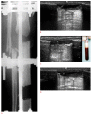Postoperative ultrasonography of the musculoskeletal system
- PMID: 25971901
- PMCID: PMC4484288
- DOI: 10.14366/usg.15006
Postoperative ultrasonography of the musculoskeletal system
Abstract
Ultrasonography of the postoperative musculoskeletal system plays an important role in the accurate diagnosis of abnormal lesions in the bone and soft tissues. Ultrasonography is a fast and reliable method with no harmful irradiation for the evaluation of postoperative musculoskeletal complications. In particular, it is not affected by the excessive metal artifacts that appear on computed tomography or magnetic resonance imaging. Another benefit of ultrasonography is its capability to dynamically assess the pathologic movement in joints, muscles, or tendons. This article discusses the frequent applications of musculoskeletal ultrasonography in various postoperative situations including those involving the soft tissues around the metal hardware, arthroplasty, postoperative tendons, recurrent soft tissue tumors, bone unions, and amputation surgery.
Keywords: Musculoskeletal system; Postoperative care; Soft tissue infections; Soft tissue injuries; Ultrasonography.
Conflict of interest statement
No potential conflict of interest relevant to this article was reported.
Figures














References
-
- Jacobson JA. Musculoskeletal sonography and MR imaging: a role for both imaging methods. Radiol Clin North Am. 1999;37:713–735. - PubMed
-
- Jacobson JA, Lax MJ. Musculoskeletal sonography of the postoperative orthopedic patient. Semin Musculoskelet Radiol. 2002;6:67–77. - PubMed
-
- Guillin R, Botchu R, Bianchi S. Sonography of orthopedic hardware impingement of the extremities. J Ultrasound Med. 2012;31:1457–1463. - PubMed
-
- Sofka CM, Adler RS. Original report. Sonographic evaluation of shoulder arthroplasty. AJR Am J Roentgenol. 2003;180:1117–1120. - PubMed
-
- van Holsbeeck MT, Eyler WR, Sherman LS, Lombardi TJ, Mezger E, Verner JJ, et al. Detection of infection in loosened hip prostheses: efficacy of sonography. AJR Am J Roentgenol. 1994;163:381–384. - PubMed
LinkOut - more resources
Full Text Sources
Other Literature Sources

